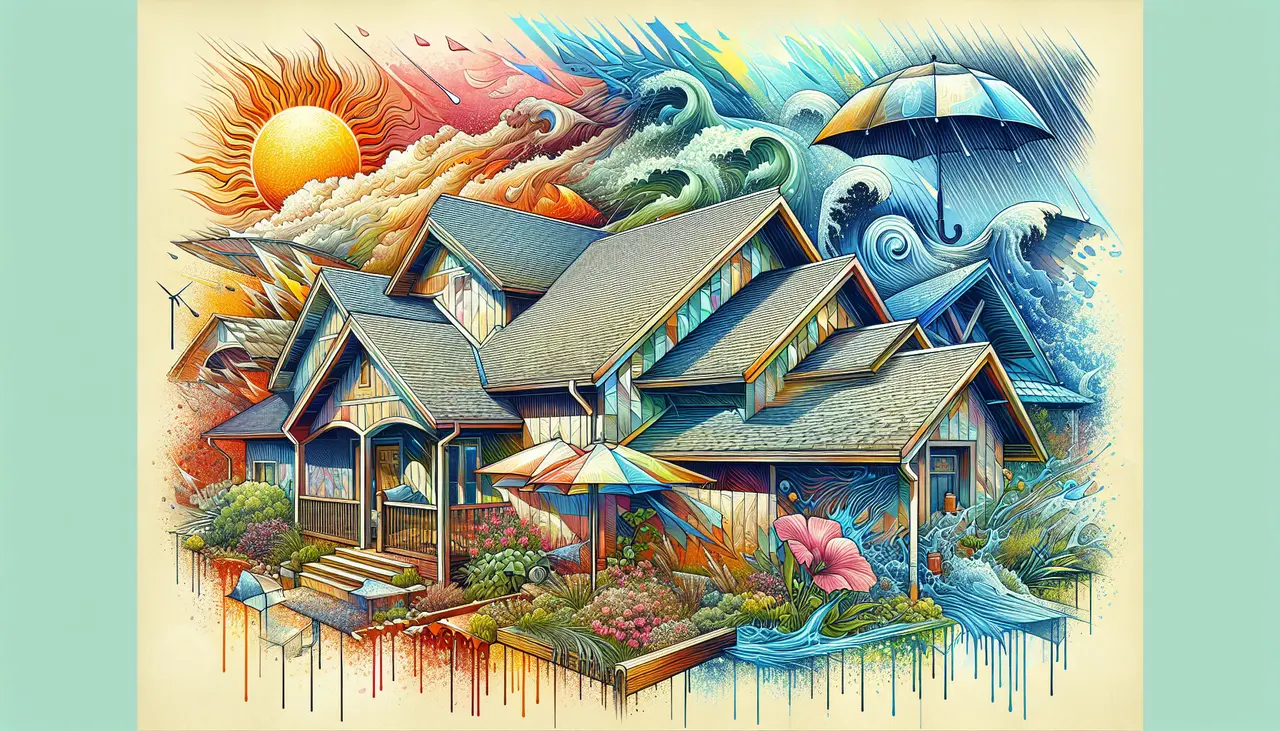Introduction to Sloped Roofing and Texas Weather Challenges
When it comes to sloped roofing in Central Texas, you’re dealing with more than the occasional heavy downpour; you’re up against a slew of weather-related obstacles. The sweltering heat, powerful thunderstorms, hail, and even tornados are all part of the package in this region. These conditions test the mettle of any roofing solution but fear not—a proper sloped roof is like armor for your home. It doesn’t just add character, it also deflects water efficiently, reducing the risk of leaks and water damage. To top it off, the right materials and construction can help it stand strong against the fury of Central Texas storms. Let’s dive into how a durable sloped roof can be your home’s first line of defense against the whims of the weather.
Advantages of Sloped Roofing in Harsh Weather Conditions
Sloped roofing isn’t just about the look; it’s a smart choice for Central Texas homes where the weather can swing from scorching heat to severe storms. The design of a sloped roof lets rain and debris slide right off, reducing the risk of water pooling and the damage that can cause. Plus, the angle of the roof means better airflow underneath, which helps your home stay cooler and reduces strain on your air conditioning system during those hot Texas summers. Durability is key, and sloped roofs are champs at withstanding high winds, a big plus when those sudden Texas storms hit. Lastly, they offer great attic space or the option for vaulted ceilings, adding that extra charm to your home while also giving you more room or a sense of spaciousness. Remember, a well-designed sloped roof not only stands up to the weather but also adds to your home’s value and curb appeal.
Common Problems with Sloped Roofing in Central Texas
In Central Texas, sloped roofing battles some tough opponents. The relentless heat waves can bake roofing materials, frying them until they crack and fray. And it’s not just the sun — when those infamous Texas storms roll in, they pelt roofs with hail like a barrage of bullets, denting and stripping away at the outer layers.
Then we’ve got the wind. Not your average breeze — these gusts can rip and tear at shingles, leaving your home’s armor patchy and weak. Imagine shingles flapping like loose sails, and you’ve got a recipe for leaks. Water’s a crafty foe, sneaking into the smallest gaps. Once inside, it’s leapfrog from a drip to water damage to mold. And mold, well that’s an enemy you don’t want to battle.
But the real kicker? It’s not always the drama of storms. Sometimes it’s just the slow, grinding change of temperatures, expanding and contracting your roof’s materials day in, day out, until they give up the fight.
It’s clear, sloped roofs have a gauntlet to run in Central Texas. But with the right choice of materials and some solid maintenance, you can give your roof fighting chance. Just know that keeping your shield strong is part of the Central Texas homeowner’s quest.
Key Materials Used in Sloped Roofing for Durability
In the battle against Central Texas’ fierce weather, a sloped roof’s durability lies in its armor – the materials it’s made of. The sun beats down mercilessly, the rains pound like a relentless enemy, and the occasional hailstorm strikes like a surprise attack. To keep a home safe and dry, you want materials that stand up to this battering.
Asphalt shingles are the foot soldiers of roofing materials, popular for their cost-effectiveness and ease of installation. Their lifespan clocks in at 15 to 30 years, and they come armed with options that resist algae and wind uplift. Metal roofing, on the other hand, is like the elite knight in shining armor. It laughs in the face of extreme weather, lasting well over 50 years with proper maintenance. It’s energy-efficient too, reflecting the sun’s fury and cutting cooling costs.
Then there’s tile – the stalwart – heavy, tough, and can endure for a century. It’s not fazed by fire or rot, but its weight can be a challenge for some structures. For a more lightweight champion, consider composite materials. They mimic the look of their heavier comrades like slate or wood but without the need for a reinforced support structure.
Understanding these materials’ strengths helps in choosing the best defense for your home against the ever-present opponent – the weather. Choose wisely, and your fortress will remain unbreached for years to come.
Design Considerations for Sloped Roofs in Central Texas
When designing a sloped roof in Central Texas, you must remember that the weather will throw a curveball. Picture heavy storms, brutal sun, and the occasional hail like an uninvited guest at a picnic; your roof must handle them all. So, what do we focus on? First off, consider the pitch of the roof – it’s crucial. Too shallow and water’s a lingering visitor; too steep, and the wind might fancy a dance. Aim for a sloped angle that escorts rainwater down swiftly but can still stand its ground against gusts. Material choice is your next big play. Go with options that laugh in the face of UV rays and mock those hailstones. Think metal roofing or high-grade asphalt shingles – they’re tough as nails and can take a beating from the sun’s relentless gaze. Don’t forget to check the color. Lighter shades aren’t just for showing off; they reflect sunlight, keeping your home cooler. And in Texas heat, a cool home is no joke. Last, make those gutters and downspouts a fortress against the downpour. They better be robust and clear, ready to drain away storm tantrums like a champ. Keep these points in line, and your sloped roof won’t just endure Central Texas weather; it’ll thrive.
Maintenance Tips to Extend the Life of Your Sloped Roof
Regular roof check-ups, especially after heavy storms, are your first line of defense; they spot trouble early. Clean those gutters like clockwork. When they clog, water damns up and leads to deterioration and rot. Inspect shingles routinely. Loose or missing shingles invite leaks, so nail them down or replace them sharpish. Trimming overhanging branches keeps those shingles safe from damage and prevents accumulation of leaves and debris. Adding proper insulation and ventilation within your attic prevents warping and cracking from temperature swings. Stick with these practices, and your sloped roof should stand tall against Central Texas weather for years.
Innovative Sloped Roofing Technologies for Weather Resistance
When tackling Central Texas’s intense weather, from scorching heat to severe thunderstorms, your roof’s ability to stand strong is vital. Innovative sloped roofing technologies are your best defense. These modern marvels, from reflective shingles that repel UV rays to impact-resistant options that laugh in the face of hail, ensure your home stays covered through the seasons. Roofing companies now install advanced synthetic underlayment for extra protection against water leaks compared to traditional felt. Besides, opting for sealant-enhanced shingles can give your roof a grip to withstand high winds. To beat Central Texas weather, embrace these tech updates and keep your home secure and dry.
Hiring Professionals: The Importance of Expert Installation
When it comes to installing a sloped roof, especially in Central Texas where the weather can be a bear, you want pros handling the job. Sloped roofs are great at shedding water and snow, sure, but they’re tricky to get right. A professional crew knows the lay of the land—the specific challenges Central Texas weather brings. They understand local building codes like the back of their hand and make sure your roof isn’t just built, but built to last.
An expert installation means using the right materials that can stand up to unforgiving sun, heavy rain, and those Texas-size hailstones. It’s not just slapping shingles on wood; it’s crafting a durable barrier against the elements. These skilled hands come at a cost, but think of it as buying peace of mind for years.
So, hire seasoned pros. They’ll ensure your sloped roof isn’t just a cover, but a dependable shield for your home, come rain or shine. And in Central Texas, that’s not just smart—it’s essential.
Cost Analysis: Investing in a Quality Sloped Roof
In Central Texas, the weather isn’t fooling around, and your wallet shouldn’t either when it’s about getting a quality sloped roof over your head. Sure, it’s not just about slapping on some shingles. You want to bank on materials that laugh in the face of sizzling sun and shrug off stormy fits. What’s the damage for this kind of peace of mind? Well, it’s a fair fight between quality and cost.
For a regular asphalt shingle roof, brace yourself to shell out from (5,000 to )10,000 or more, depending on the size of your fort—err, I mean house. But here’s the kicker, pay less now, and you might just be dancing with more repairs later. These fellows typically last about 20 years, which isn’t shabby.
If you’re leveling up to metal, consider your coin purse lighter by about (10,000 to )14,000 or more. Steep? Maybe upfront, but these metal marvels can stand their ground for a whopping 40 to 70 years. In the end, it’s all about betting on what suits your pocket and your patience for upkeep.
Remember, a quality sloped roof isn’t just a purchase; it’s an investment in your homestead’s resiliency against whatever Central Texas skies throw down. Choose wisely, partner.
Summary: Maximizing Sloped Roofing Performance in Central Texas Weather
In Central Texas, the climate throws a mix of scorching sun, heavy rain, and at times, fierce hailstorms at our homes. To keep a roof over your head that withstands this weather, it’s crucial to maximize the performance of your sloped roofing. The key? Choose materials wisely; metal, asphalt shingles, and clay or concrete tiles top the list for durability and heat resistance. Metal roofs reflect the sun’s rays which help keep your home cooler, while asphalt shingles are cost-effective and easy to repair. Clay and concrete tiles can endure the wrath of hail and offer a classic look, but they’re heavier and need sturdy support. Regular inspections are a must—twice a year should do the trick—to catch any damage early and fix it fast. Proper ventilation and insulation also play pivotal roles; they keep the attic cool and fight against moisture that can spell disaster for any roof. Stick with these guidelines, and your roof should stay solid and secure against the unpredictable Central Texas weather.







